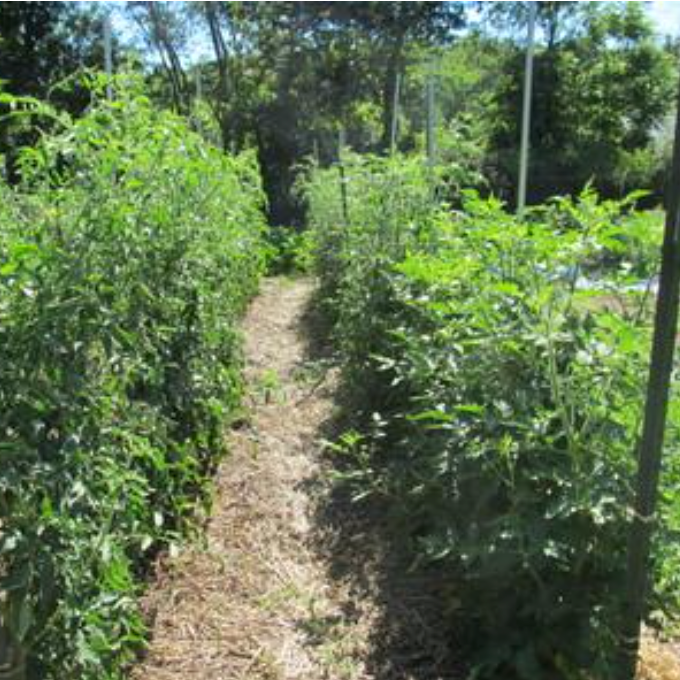
Troubleshooting in the Tomato Patch
Every season, as soon as the first fruits start to ripen, I always start to panic. That's when my tomato plants begin showing signs of spotting, yellowing, and other strange symptoms that always put me on high alert. After the Late Blight epidemic of 2009, the question that seems to pop up from a lot of home gardeners is, "Is this Late Blight?" The good news is, not all spotting on plants is devastating. In the North East, some spotting and yellow is inevitable. However, learning to diagnose serious plant diseases is important, because, as with Late Blight, fast action is necessary upon spotting the first symptoms in order to help prevent a major outbreak.
The past three years, I have consistently used Cornell's Tomato Disease Identification Key. It's a huge database with lots of photos. A very good place to start. Inspect tomato plants as often as you can, daily if possible, when the plants are dry. Be sure to check all parts of the plant, the fruit, leaves, stem and base for symptoms. Many tomato ailments are distinguished by the parts of the plant that they affect, so this can be very important. When you see something that shares the Late Blight characteristics, be sure to call your local extension agency to have a tissue sample tested.
(Check out another great resource from Cornell, Avoid the Late Blight Blues. It includes tips to help you prevent, identify and react to this devastating fungus.)
In these parts, two common tomato issues that get confused with Late Blight are Blossom End Rot and Early Blight. Although they look quite serious, with just a bit of care, these two issues won't effect your tomato harvest in a major way.
-
Blossom End Rot (BER) was the first thing I noticed last week while inspecting tomato plants after our in
 sanely hot, dry spell finally broke. Though nasty and sad, BER is physiological. BER occurs when plants have difficulty getting calcium where it needs to go, to the extremities of the fruits. This can occur simply from over-watering or under-watering, calcium deficiencies in the soil, periods of drought followed by heavy rain, or a combination of all of the above. The tomatoes most susceptible to BER are the long sauce types, like Amish Paste and Mama Leone. To prevent it in the future, try to stick to a watering schedule with your tomatoes, and check your calcium levels by having your soil tested. Amend your soil with calcium if recommended.
sanely hot, dry spell finally broke. Though nasty and sad, BER is physiological. BER occurs when plants have difficulty getting calcium where it needs to go, to the extremities of the fruits. This can occur simply from over-watering or under-watering, calcium deficiencies in the soil, periods of drought followed by heavy rain, or a combination of all of the above. The tomatoes most susceptible to BER are the long sauce types, like Amish Paste and Mama Leone. To prevent it in the future, try to stick to a watering schedule with your tomatoes, and check your calcium levels by having your soil tested. Amend your soil with calcium if recommended.
The plants in the Seed Library demonstration garden were struck with Blossom End Rot on the newest fruits, leading me to suspect the weather as the most culpable cause. Since these fruits are still tiny, I decided to prune them off so the plant can stop sending energy to them. In some cases, BER effects larger, fully formed fruits and is simply on the end. If you wish to eat the good flesh from these damaged fruits go right ahead, just be sure to cut out the nasty looking core.
Blossom End Rot only affects the fruit.
-
 Early Blight might sound devastating given its cousin's reputation, but it isn't necessarily so bad, and it's everywhere. Early Blight lives in the soil, and typically affects the lower portions of the plant first and moves up the plant as the season progresses. It spreads through water, and can also be an indication of over-watering. I have noticed that Early Blight seems to appear after the first fruits start to ripen, perhaps because the plants are dividing their energy to maintaining growth and seed production through fruiting. Whatever the real cause, you can lessen the effects of Early Blight by pruning off and discarding of affected leaves, mulching with a clean straw mulch, amending your soil and applying a foliar feed when the plants start to fruit.
Early Blight might sound devastating given its cousin's reputation, but it isn't necessarily so bad, and it's everywhere. Early Blight lives in the soil, and typically affects the lower portions of the plant first and moves up the plant as the season progresses. It spreads through water, and can also be an indication of over-watering. I have noticed that Early Blight seems to appear after the first fruits start to ripen, perhaps because the plants are dividing their energy to maintaining growth and seed production through fruiting. Whatever the real cause, you can lessen the effects of Early Blight by pruning off and discarding of affected leaves, mulching with a clean straw mulch, amending your soil and applying a foliar feed when the plants start to fruit.
Early Blight primarily affects the leaves, and will move to the stem.







